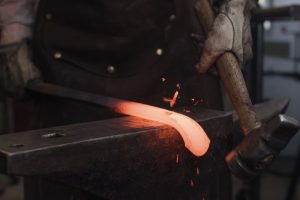The pretty, petite woman pulling the molten steel rod from the glowing forge and shaping it, blow by blow with a hammer, into delicate leaves that will adorn a garden gate is not what people typically think of when they visualize a blacksmith. Most of us grew up watching Westerns in which the town blacksmith was a burly man wrapped in a leather apron, biceps bulging as he hammered an errant horseshoe on his anvil!
Susan Bond wields a mean hammer, and she knows her way around an anvil, but her specialty is architectural decorative ironwork. Working with a forge, she fashions functional yet artistic pieces that have a grace and fluidity of movement that belie the rigidity of steel.
“What I love about blacksmithing is the art of heating steel and shaping it into something that’s completely different from what it started as,” Bond said. “When I first started smithing, I was fascinated by the fact that iron and steel could be stretched, twisted, molded and shaped by hammers, dies and other implements to execute change.”
Bond typically starts with a 20-foot long rod of low-carbon steel known as “mild steel.” She’ll use a propane-powered forge to heat the rod until it glows a yellow-orange color, indicating it’s at forging heat between 1,300 and 2,400 degrees Fahrenheit. Forging is a cyclical process: the smith pulls the iron from the forge and hammers it on the anvil as the metal cools, then heats the iron again, repeating the process until she’s achieved the shape she wants. The smith holds the heated iron with large metal pliers known as tongs.
Bond uses a combination of forging and joinery, or welding, to create the effect she wants. People often confuse welding with blacksmithing, Bond says, but while complementary, the two techniques are completely different.
“Welding is connecting two pieces of steel, while blacksmithing is heating a piece of steel and manipulating the shape,” she clarified. “The art of combining welding and blacksmithing is so you can’t tell which is which. A lot of my work contains traditional joinery. The weld is there for structural purposes, but I cover it up with decorative blacksmithing.”
There are several basic techniques used in blacksmithing: drawing out, which makes the piece of metal longer and thinner; upsetting, which makes the piece shorter and thicker; bending, where the smith carves and shapes the metal; chiseling, in which the metal is shaped or cut with a chisel; chasing, where the metal is indented on the front with a blunt tool; punching, creating a hole; twisting, in which the ends of the metal are twisted in opposite directions and repoussé, used in sheet metal, where the metal is pushed out from the back to create design or more depth. Bond will often employ two or more techniques to achieve the effect she wants.
Her trade depends on her tools, and she is adept at making the tools she needs if not available commercially. “I make my bending forks out of old grader blades off the machine used to pave roads,” she said. “Blacksmiths covet old grader blades because they are so hard. It’s the gold mine for making tools!”
Bond has always had the ability to coax beauty out of whatever materials she encounters; she is an accomplished fiddle player and quilter, and once built a custom home for herself. She stumbled upon her life’s work while visiting an old gold-mining town near Yosemite with her parents. They walked to the town’s cemetery that was enclosed with a fence and gate crafted of decorative iron.
“I knew in an instant that that is what I wanted to do,” smiled Bond. “I said to my dad ‘I really love this stuff! How do they do it?’ He looked at me funny and told me that my grandfather had started blacksmithing decorative ironwork after an accident at a steel plant. I had no idea!”
With forging in her family genes, Bond went on to apprentice with some of the most respected blacksmiths in New Mexico and in Berkeley, California. In Boise, she discovered a mentor in Nahum Hersom, an internationally renowned smith who specialized in repoussé. He was 88 years old at the time.

“I have incorporated a lot of repoussé into my work,” Bond said. “It gives the piece a lot of movement.”
Bond’s blacksmithing spans a range of functional ironwork. In addition to custom work for homes, she created a “wave form” handrail for Rotary Park in McCall, bronze urns for a Boise funeral home, and tabernacle candles, holy water bowls and a hammered bronze tabernacle dome for St. Paul’s Catholic Church in Nampa.
“Hand-forged iron gives a personal element to a home that will never come from mass-produced manufactured steel out of a big-box store,” she said. “It adds a quality and creativity that can only be done by hand.”
The Anvil Design
The anvil design with which we are familiar today is known as the “London Pattern,” commonly used since the 1880s. It has a pointed end called a horn, where the smith can hammer different curves. Some anvils have multiple horns of varying sizes. The step is between the face and the horn. It’s used to cut the metal while hammering. The face is the flat area where most of the hammering takes place. There are two holes in the flat top: the hardy hole is square and allows tools such as chisels or dies to be secured in the anvil. It’s also used for bending and punching. The pritchel hole is round and serves the same functions as the hardy hole.
